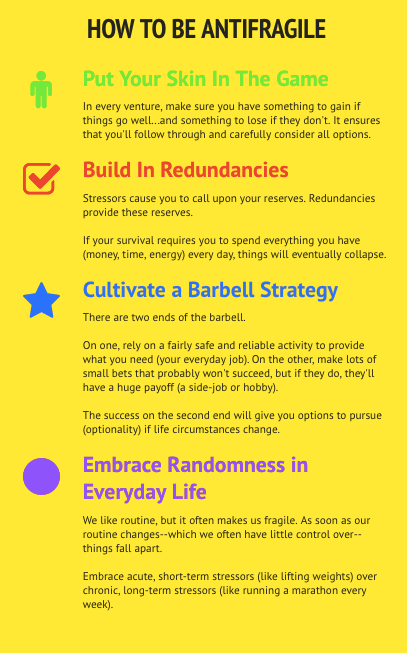Antifragility for Dummies (Or Why You Need to Start Taking Cold Showers!)

Everything in the world can be broken down into three categories:
- The fragile: These items break under stress. Think of a glass falling off of a table.
- The robust: Under stress, these things stay exactly the same. Think of a rubber ball falling off the very same table and bouncing up and down.
- The antifragile: These objects actually become stronger as a result of stress—up to a point, and allowing time for recovery. Here, think of the mythical hydra, which grows two heads back where one is cut off.
Almost everyone is aware of the first two, but the third is neglected. As a result, we often think that “robust” is the alternative to “fragile”.
We then design our lives accordingly: aiming for “secure” jobs at large corporations, pouring our life savings into buying a house with a reasonable mortgage, and trying to inoculate ourselves from the stresses of everyday life.
This is the basic lens through which author/trader/flaneur Nassim Taleb invites us to view the world in his Antifragile: Things That Gain from Disorder. I will be writing far more on how the book could change your daily life in the coming weeks, but this article aims to be the reference point for what antifragility—at its core—really is.
Why you need to become antifragile…now!
The biggest lie we ever tell ourselves is that we can predict the future. We take our circumstances as they are right now, add in our knowledge from past experiences, and paint with a broad brush what we think our future will look like.
When major surprises pop up, we tell ourselves that we saw them coming from a mile away. This includes societal anomalies (“I knew real-estate was a bubble before the Great Recession”) and personal ones (“She showed all the signs of wanting a divorce for months”). What we miss, however, is the fact that in reality, we had no idea what was coming. If we did, we would have prepared differently.
Instead of spending precious hours trying to predict what the future holds, we need to surrender to the fact that we’ll never know what tomorrow brings. By doing so, we can pivot our focus—we can design a life that will not only survive when unexpected stressors pop up, but it will actually become stronger.
The sooner you get started, the more the benefits of an anti-fragile life will start compounding for you.
How to live an antifragile life: The view from 30,000 feet
This article would be impossibly long if we explored every single way that you could design an anti-fragile life. Instead, here are the broad ideas that, when taken into consideration, will help guide your decision making process.
Underpinning all of these ideas is this truth: you need to sacrifice the desire to efficiently maximize your life (financially, socially, for short-term stature, etc.) in favor of accepting a high probability of small setbacks, with occasional huge payoffs.

As promised from my title, taking cold showers is one very simple way to practice antifragility. If your body become accustomed to such practices, you will find yourself in a superior position when the water-heater is on the fritz, or you can no longer afford to pay your electric bill. Incidentally, science has also found that it can improve your immune system!
I know many of you have read the book, if you had to choose four broad takeaways from Antifragile to apply to your life, what would they have been?
I'm too dumb to know what you're talking about.